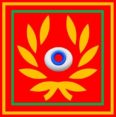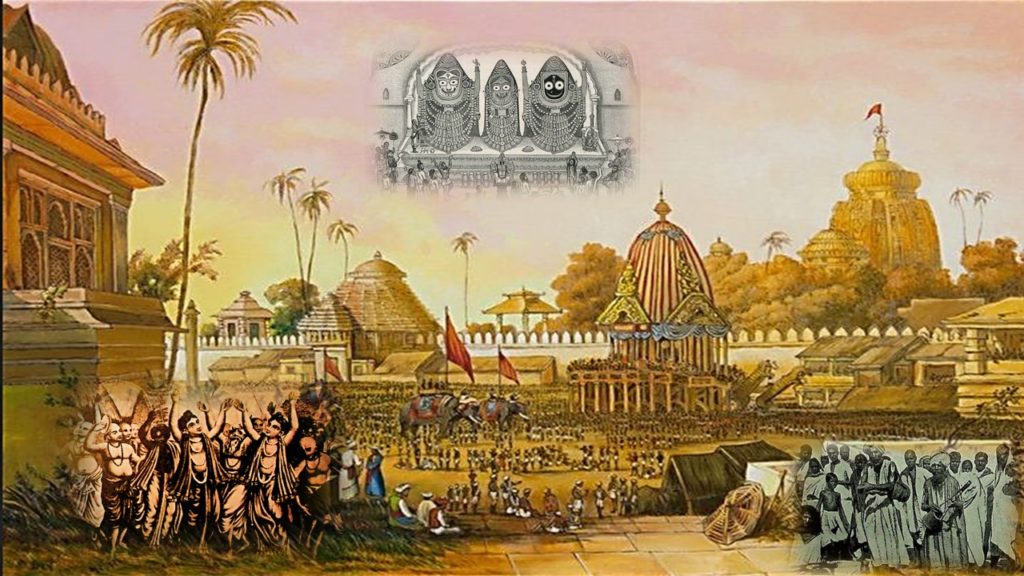At the same time that courtly love, Venus and Cupid were making their influences felt in minds upon European and Middle Eastern soils, in the Orient we find Purusottama Vishnu (seen by Vaishnavas as being an aspect of Vishnu, one of Vishnu’s many qualities, names and forms, associated with love) was worshiped in his own right as an important branch of Deity. Other aspects of Vishnu such as Madhava Vishnu, which was associated with a blue nila stone was important as well, in the area by the sea, upon which Purusottama graced in Orissa. Madhava is an important name of Krishna indicating his conquering of the intoxicating qualities of madhu, associated also with honey, possibly fermented honey. Vishnu as the killer of the demon Madhu could well then be meaning the bad intoxicative qualities of fermented honey or something added to the beverage to make it of a different nature? Madhava is above the Madhu, the killer of the demon, the intaker of the bad qualities purified? Krishna’s brother was fond of fermented honey called Varuni. Madhava is also an important part of the Krishna tradition as one of Krishna’s chief names, and is thus entwined naturally with the tradition of this deity of love which was also entwining with that of the universal Jagannatha (‘Lord-Natha of the Universe- Jagan’), who means many things to the many different devotees too. In some traditions he the Goddess Kaali, some Shiva, some even saw him as Buddha and Vajrayana Buddhism, that form of Buddhism associated with the secrets of beverages, of intoxicating and psychoactive substances according to some, was the Buddhism of Orissa, the region of Jagannatha. This confluence of Madhava Vishnu associated with a blue stone, also associated with the Krishna deity associated with a brother who drinks fermented honey (moreover both chew pan and pan itself, associated with acacia, has a history of shamanic use in the Pacific cultures of aboriginal ancients and always offered to the various deity forms in ritual in India) and also Purusottama Vishnu was mainly in Orissa also a place of Vajrayana and is towards the east of India’s seaboard. Eventually through various twists and turns these confluences and associations, at times separate from one another, came to be centered in Jagannatha Puri, and associated with Jagannatha, which became the spiritual heartland of Orissa. My aim however here is not so much with the alchemical elixiral, and the psychoactive uindercurrents which alas, are still not delved into in any depth even in our modern times even after a psychedelic breakthrough along with a more open understanding of the confluences of vegetation with human being in the creation of the visions which led to the religions. My aim is rather with the subject of chess and its number structure as part of a wider stream of the confluence of board games, mandalas and yantras and more specifically associated with traditions of love and devotion.
Jagannatha is specifically associated with Purusottam Vishnu, right from the very start, yet nevertheless, Jagannatha is seen differently according to persuasion, whether Shakta Goddess (some see Jagannatha as Kaali- hence not a male deity but female), Shaivite (specifically the Shaivite traditions of Bhairava) and various tribal divinities integrated also as well as Buddha. In fact the first uses of the term ‘Jagannatha’ as one indicating an Absolute Deity Godhead worshiped with devotion, comes out from Vishnu Purusottama traditions, whose emphasis is derived from various Purana literature, where sections of them have been ‘carved up’ into separate texts, weaved and elaborated on in commentaries, expanded thus and widened and bringing forward things not in the Puranas but rather things that run parallel to the Puranas and Upanisads. These are the Purusottama Mahatmyas. These central key texts of the Jagannatha-Purusottama traditions, especially after the later 1000s and early 1100s onward (when chess was also present in Europe and starting to become popular, and when the courtly love tradition was arising alongside the earliest Grail legend materials) ushered in the new from the old. A great river destined for things concerning Chaitanya as Krishna as Jagannatha later on as this were the traditions Chaitanya settled in.
The Jagannatha-Purusottama-Vishnu tradition from this time onward became more and more promoted as one of India’s main traditional branches, one in which the Deity procession in great carts of interesting symbolism and structure in themselves, proceeds towards sea shore temples and back again to the sacred blue hill. This attracts millions of pilgrims every year, and has become one of India’s main pilgrimage sites and the central confluence of the various main Indian traditions of spirituality, love and devotion in their most intense form, not to mention things also alchemical. It is curious that this tradition of pulling deity carts in procession was for the first time taken outside of India to San Francisco’s Haight Ashbury, the centre of the psychedelic renaissance and from there spread to every city around the world!
It was the Ratha-Yatra chariot festival of Purusottama, by the sea shore, which was referred to in the work Anargha-raghava, wrote by the dramatist Murari (estimated by different scholars to be anywhere in the period between 900 and 1135 AD) wherein Purusottam is described as being in a temple by the sea shore and is of a dark blue bodily color, which is the color of wisdom, of Vishnu, of Krishna. This color is said to resemble that of a blue sapphire. This poet dramatist mentions how this sapphire blue Purusottama resides on the shore of the salt ocean (there are various oceans representing the different levels of the material realm in the tradition the salt ocean being one, others milk, alcohol, clarified butter etc) in loving sporting pastimes with Kamala his consort, upon whose breasts he draws patterns with musk paste. Hence we see not only the Kamalaja governed by Lakshmi, Vishnu’s wife, but also that Lakshmi herself is called in this instance Kamala. Thus we see Kama again, kindred traditions that relate to Kamadev/Eros/Cupid.
Presumably these patterns Kamala’s breasts are adorned with, are the geometric designs which underlay the creation’s peaks made of mandalas and yantras. Anyway here it is said the breasts of this Lady Wisdom resemble pitchers, and if we think about it, pitchers are indeed vessels, like the Grail in a sense, like the elixir anointing vessel, like the crucible if the alchemist. Anyway, Purusottama is dark blue as we have seen, and is in this compared to the Tamal tree, as is Krishna, and he is as we have seen, the blue sapphire jewel, which he also has in his crown. This crown is of course placed on the forehead of the entire creation of the three worlds. This court poet and dramatist mentions this Deity by the sea shore being taken on his chariot parades by worshipers. He thus refers to an ancient tradition there of Purusottama- Vishnu by the sea shore in that place what later came to be known as Jagannatha Puri (but not mentioned as called that by this poet). He is also revealing that in the time period he writes it was an ancient tradition well established (placing it before the time period of 900-1135). He was writing in the time period just before the tradition of Jagannatha specifically in the shape we know of him, arose in fame under King Chodagangadeva, who is credited with building Jagannatha’s new Temple. Hence, here in the roots of the tradition, Purusottama is associated with a conjugal love tradition of the breast pitchers of Kamala.
Another early tradition attests in stone inscription that a son of Sarasvati, cursed to take birth on earth, re-entered the heaven he had fallen down from, through the salt ocean by the side of Purusottama. Thus the waters of the Goddess are in a sense the ends of wisdom and the vehicle through which true and humble jnana, or knowledge, is attained. It is by the sea shore that this fallen son of the Goddess of learning, Damodara, gets a vision of Purusottama and only through this attains the qualifications to return back to heaven. This baptismal like turn from grace and return by aid of water is as a result not only of his pride, but also because he offended Brhaspati, the priest of the gods. He is restored back to grace as the son of the goddess of learning, Sanskrit alphabet and wisdom linkeages, once again. This story is found on an inscription elsewhere in India, in the neighbouring state to Orissa, Madhya Pradesh, in the Maihar district, which attests to the fame of the Purusottama temple by the sea shore in the middle of the tenth century. In a certain sense then Purusottama Vishnuism by the sea was Jagannath-ized later on due to various reasons of new old traditions resurfacing from elsewhere destined to blend with other strands. The fruit tree was growing in the garden. This was especially in the time period of the building of the present temple of Jagannatha in Puri, under the king Chodaganagadeva (ruled. 1077-1147), his son Anangabhimadeva (ruled. 1190-1198) and the son of this son Rajarajadeva (ruled. 1198-1211). Thus the tradition of Purusottama Vishnu changing into Jagannatha Purusottama arose from the same time period, which was also the time of the Templars and the Troubadours, the first stirrings of the rose of amor, Venus and Cupids garden chess of the alchemical refinement of love, the love in separation of Tristan and Iseult.

